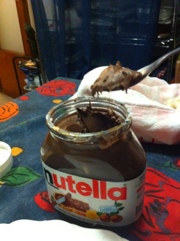A few thoughts for World Nutella Day
Everyone has their comfort food. I have friends who zero in on the nearest pint of Haagen Dazs or Ben & Jerry’s ice cream. Growing up in Wisconsin my consolation for being dragged out to cross-country ski during saturday morning cartoons was a cup or two of hot chocolate with marshmallows.
One of the problems with some comfort foods is get they are not always there when you need them. Good pizza and quality draft beer need the right restaurants or pubs, ice cream needs a fridge, and hot chocolate needs something to heat it up.
Good Chocolate, be it Swiss chocolate, boeri and gianduia chocolates from Piedmont, or your favorite fix can do the trick, but then you risk falling afoul of the dark versus milk-chocolate debate…and why choose one when you can have them both?
As American pop-culture foods like colas, colorful breakfast cereals, corn chips (crisps!) and McDonalds spreads across the globe, an Italian multinational has been quietly spreading its comforting paste the other way….like a tasty plague.
With Nutella, you don’t need anything tools or instruments to reduce depression whilst widening your waistline; if your fingers are clean not even a spoon is needed (and like chocolate-covered pretzels a little bit of salt makes it more savory).
And there are more benefits. It doesn’t melt like ice-cream but you can mix it with your favorite gelato (or even use it to correct the bad stuff), and if a stretch you can place a dollop in your steaming-hot espresso for a double pick-me-up.
But the best part of Nutella is that you can keep a jar hidden away for emergencies….like being snowed-in like we are today, or after an unpleasant Superbowl game.
Just reached for the jar…and a spoon!
February 5th is World Nutella Day (http://www.nutelladay.com/ )
Follow me on Twitter http://twitter.com/#!/JoshuaLawrence
For those of you reading this on Facebook or elsewhere, it was first published on carbonara.wordpress.com
http://www.facebook.com/pages/Carbonara-by-Joshua-Lawrence/291542554139?ref=ts
Nutella Day was founded by the great people behind Bleeding Espresso
and
Ms. Adventures in Italy





















